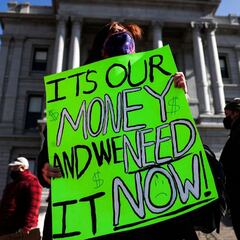Stimulus relief bill: when do unemployment benefits end?
President Joe Biden's American Rescue Plan has been a long time in the making, even prior to his inauguration, and an extension to jobless benefits is a key element.

On Saturday the United States Senate approved a Democratic compromise measure setting federal unemployment benefits for workers hit by the coronavirus pandemic at $300 per week through until 6 September 2021.
- What's the next step for Biden's relief bill after it was passed by the Senate?
- How to claim unemployment insurance tax waiver
- Who could qualify for the third stimulus check?
- Tax Return 2021 IRS delay: how long could it take and when will I be refunded?
Stimulus relief bill: unemployment benefit extension
President Joe Biden's $1.9 trillion covid-19 relief bill is expected to make it through the Democrat-led House of Repressentatives by Tuesday or Wednesday and signed into law by the end of the week. The amendment to the bill supersedes a previously adopted Republican measure that would have cut off payments on 18 July despite the ongoing impact to millions of households of the coronavirus pandemic.
As well as the extension, there is also a new tax-free unemployment benefits allowance that will allow recipients with an annual household income of less than $150,000 to avoid paying tax on the first $10,200 that they receive.
News: Senate Democrats have struck a new deal on unemployment insurance benefits, according to Democratic aide. The benefits will now go through September at $300 per week (change from House through August, $400 per week)
— Burgess Everett (@burgessev) March 5, 2021
And now the first $10,200 of UI benefits are non-taxable
The target date to get the new bill signed into law is prior to 14 March, when the current federal funding expires. However, people should be aware that there may still be an interruption in payments for recipients in some states as it can sometimes take weeks for the respective agencies to enact benefit extensions.
Unemployment benefits: additional extentions
The $300 weekly payments will be the most universally available unemployment support, but there is also federal funding for other groups.
The mixed-earner supplement is also extended until 6 September and will provide an extra $100 per week for those whose income is a mix of self-employed and wages paid by their employer. They are often given a lower state-issued unemployment benefit because their paid salary is lower.
“I think everybody is expecting a couple weeks of chaos where workers may not get payments on time.”
Elizabeth Pancotti, unemployment expert at Employ America
There is also an extension to the Pandemic Unemployment Assistance programme, which covers the self-employed, gig workers, part-timers and others who are not able to receive regular unemployment benefits. The support for this group is available until 6 September as well and is capped at a cumulative total of 79 weeks, up from 50.
Unemployment benefits: how to apply
To apply for the benefit payments you need to file a claim with the unemployment insurance programme in the state where you last worked. States have their own procedures for doing so, but can usually be filed in person, by telephone, or online.
Related stories
Here we provide some general tips to get started.
- As soon as possible after you become unemployed, you should contact your state's unemployment insurance programme.
- The claim should usually be made with the state where you last worked. If you worked in a state other than the one where you now live or if you worked in multiple states, the state unemployment insurance agency where you now live can provide information about how to file your claim with other states.
- To file the claim you will need addresses and dates of your former employment, so be sure to give the correct information to avoid delays.
You can find the contact information for your state's unemployment office on the Department of Labor Online Portal.

